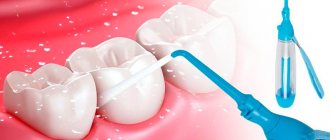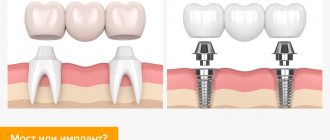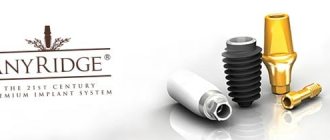Why implantation?
All methods of dental prosthetics prior to implantation negatively affect the condition of the oral cavity in the future, often causing premature wear and loss of teeth. In particular, the manufacture of bridge-like prostheses - bridges, as they are also called - requires the depulpation and preparation of two, and sometimes three, teeth to replace just one lost tooth.
Such radical treatment, to put it mildly, is not beneficial for the jaw system and leads to overload of the supporting units with further root inflammation and tooth loss. At the same time, the average service life of “bridges” is 6-7 years.
The situation with removable dentures is even more complicated: for any removable device, the support is the gums and bone tissue of the jaw, which, in principle, is not adapted to a full chewing load. As a result, a chronic inflammatory process develops, and the bone atrophies and dissolves.
Why is implantation the best method?
In more than 67% of cases of edentia, the most optimal way to solve the problem is to install a dental implant. This is an operation to implant a pin that performs a supporting function for the prosthesis.
Implantation is rightfully considered the most effective method of dental restoration. At a reasonable price for dental implants, their installation provides a huge number of advantages:
- no need to grind healthy teeth;
- any dental unit can be restored;
- implantation solves the problem of both partial and complete adentia;
- maximum reliable fixation of the prosthesis;
- high chewing efficiency;
- protection against bone atrophy;
- wide selection of prostheses.
Modern technologies for manufacturing implants guarantee excellent quality and durability of products. The implant serves the patient throughout his life. The most important thing in the implantation procedure is its correct implementation based on reliable diagnostics, taking into account all the features and indications for implantation of a particular patient. In this case, the role of the implantologist plays a decisive role. That is why at NovaDent we pay special attention to the selection and training of our doctors and specialists.
Pros of implants
High aesthetics
Durability and reliability
Function restoration
Survival rate up to 97%
What to prepare for
Dental implantation is a technique that does not have the disadvantages of previous generations of prostheses. Implantologists consider it as the only way to restore lost teeth that does not harm the health of the oral cavity and has an unlimited (usually lifelong) service life.
Important! No other prosthetic method provides such high aesthetics as implantation.
But it should be taken into account that dental implantation is not a simple procedure during which an implant is simply inserted in place of the missing unit. The future tooth (more precisely, its root) must have a certain size, the proper position and direction, and a strictly defined inclination are selected for it.
In addition, it is necessary to restore all the tissue surrounding the tooth - and, first of all, bone tissue and gums. It is this comprehensive approach that allows us to achieve reliability, impeccable aesthetics, and durability of implant treatment.
Implantation is a slow process, except for one-stage implantation, as well as the “all on 4” and “all on 6” techniques. Treatment usually involves several stages, despite the common name of "two-stage" surgery.
Treatment always begins with diagnosis, which is the first and, perhaps, the most important stage that determines its outcome. Based on the results of the preliminary examination, a decision is made on implantation technology, types of implants, and the details of the upcoming operation are thought out.
Important! It is necessary to prepare for the fact that during the implantation process you will have to go through several stages. A standard scheme applies to all patients, so we have prepared a detailed description of each stage of dental implantation.
Answers to popular questions
Is it possible to install implants for diabetes?
Controlled diabetes mellitus is not a contraindication to dental implantation. Based on the results of the analysis for glycated hemoglobin, patients are divided into three groups:
- less than 6% - dental implants can be placed without any restrictions;
- from 6% to 8% - implantation is possible, but with minimal risk (special preparation is required);
- more than 8% - surgery is possible only after the patient reduces the level of glycated hemoglobin to the required levels.
The Family Dentistry clinic successfully performs dental implantation for diabetes mellitus according to an individual treatment plan, taking into account the specific clinical picture. We try to use technologies that allow us to avoid bone grafting - the operation is less invasive (traumatic), and healing is easier. In addition, we install Straumann implants with the hydrophilic surface SLActive, which eliminates blood supply disturbances in diabetes and promotes successful osseointegration in bone tissue.
Is it possible to place implants with periodontitis or periodontal disease?
Yes, you can. But treatment is required first, incl. Possibly gum and bone grafting.
With periodontitis, bone tissue atrophies, so osteoplasty may be required at the time of implantation of a titanium rod into the jawbone. Some clinical situations allow you to install an implant immediately after gum surgery for periodontitis, while others require up to 6 months for the bone material to engraft.
In patients with periodontitis, the gums are less dense and decrease in width and height. This is dangerous because a pocket may form between the neck of the implant and the gum, in which bacteria will accumulate. As a result, there is a high risk of titanium screw failure. That is why the dental surgeon first performs gum surgery.
What anesthesia is used to place dental implants?
Local anesthesia is most often used. It is enough so that the patient does not experience any pain when installing implants. A combination of local anesthesia with sedation (a state of drug-induced semi-sleep) helps to cope with the experience.
It is important to understand that the jawbone is not innervated. Therefore, it is necessary to numb only the mucous membrane, which local anesthesia copes well with.
Why does an implant take root faster when installed in the lower jaw than in the upper jaw?
Yes, titanium rods implanted in the lower jaw take root within 2-4 months, and in the upper jaw - from 3 to 6. This is due to the fact that the mandibular bone tissue is more dense.
What are the dangers of smoking after implantation?
Until about 10 years ago, smoking was an absolute contraindication to the installation of implants, and many dental clinics simply refused such patients who were at risk.
Nowadays, even heavy smokers are implanted, but smoking remains the worst enemy of dental implants. It promotes the growth of bacteria in the mouth and accelerates the formation of plaque. It also leads to irritation of the mucous membrane and constriction of blood vessels, slowing down the healing process of tissues after surgery. Thus, smoking not only significantly slows down the process of engraftment of artificial roots, but also increases the risk of their rejection.
Can I drink alcohol after getting dental implants?
It is advisable to avoid alcoholic beverages not only while taking antibiotics after implantation, but also for the entire period of osseointegration (i.e., 3-6 months) for the following reasons:
- irritates the mucous membrane, slowing down the process of engraftment of the titanium rod;
- dilates blood vessels, causing bleeding at the site of implantation of the artificial root;
- increases the risk of developing hematoma.
Still have questions about installing implants? Get a free consultation with an implantologist.
| Expert, author of the article: Akhtanin Alexander Pavlovich Orthopedic dentist, implantologist 35 years of implantation experience Material updated: October 11, 2022 |
Stage 1: diagnosis
It may take some time to choose a clinic and an implantologist, since this is one of the key points in the whole story. In addition, you need to get to know the orthopedist and, if necessary, the therapist - these doctors will also take part in the process of implantological treatment. If everything is satisfactory, then before implantation an examination is carried out by a surgeon.
He will tell you whether it is possible in principle to place an implant in this patient, and will develop further treatment tactics based on the following data:
- general oral health;
- the presence and condition of neighboring teeth and gums, which are located next to the future implant root;
- bite;
- hygiene quality;
- financial capabilities of the patient.
The price is usually included in the total cost of treatment, which is carried out in most clinics on a turnkey basis. The doctor will announce the approximate cost, the final price is determined after diagnostic testing and consultation with an orthopedist. If a patient needs the help of a physician, hygienist or periodontist, then their services should be considered.
Diagnostics includes instrumental and laboratory studies, without which surgery is impossible. These examinations are necessary to exclude a number of complications after the introduction of implant rods and achieve extremely good treatment results.
How to calculate the cost of implantation?
When dental implantation is performed on a turn-key basis, the cost that is initially set may increase due to other additional operations and services. The cost of additional procedures is negotiated separately and is charged on top of the established price. In general, when choosing this method, the patient receives guarantees of high-quality execution of the procedure, since it is much easier for the doctor performing the operation to monitor the patient’s condition.
To calculate the cost of any type of implant installation, you can use a special calculator. Dental implantation is a rather complex procedure, when calculating the cost of which many points must be taken into account - the cost calculated on the calculator is highly accurate, since all these points are taken into account. However, do not forget that the exact price of dental implantation is discussed with a specialist doctor during the initial examination.
How much do dental implants cost?
The question is quite controversial, since there are many manufacturers, as well as promotional offers from various clinics. Price components include the cost of implants, crowns and other materials.
Of course, an implant can be found at a price of about 20,000 rubles per unit, but it is unlikely that anyone will be responsible for the quality. Moreover, it is worth paying more attention to new, unverified manufacturers. On the Russian market, these are representatives of South Korean brands that quite actively import dental implants. The cost of their products can range from 20 to 50 thousand rubles per implant. In addition to these countries, implants are produced by the USA (SuperLine, Bicon) - cost 50 and 75 thousand, respectively, Israel (Alpha Bio, MIS) - cost 25-36 thousand rubles, Switzerland (Strauman, Nobel Biocare) - from 50 to 100 thousand rubles per one implant, France (Anthogyr) – 48 thousand rubles, Germany (Ankylos) – 60 thousand rubles, Sweden (Astra Tech) – 65 thousand rubles.
Which brand to choose is up to you to decide, but it may be a good idea to read reviews from patients on specialized forums who have already undergone this procedure and can share their experience and recommendations on this issue. How much does a dental implant cost? This is a very pressing question for people who have decided to reconstruct their oral cavity by installing new implants. Another question immediately arises - which manufacturer to choose? Firstly, you can pay attention to the products of the Implantium brand, which are used by many dentists. In addition, SuperLine, which uses modern developments in the field of implantation and produces fairly reliable dental implants, also shows good results. Their cost can be 20 - 25 thousand rubles. Another additional positive quality of their products is the general uniformity of the internal diameter of the required holes. The quality of these brands has been tested by practice in Russian markets.
But this concerns the material itself, and how much does it cost to install a dental implant?
The operation itself will most likely cost approximately 35-50 thousand rubles. This includes a full examination of the oral cavity with diagnosis, selection of a suitable model, the operation itself and post-operative care and adjustment if necessary. These activities practically double the total cost, but are absolutely necessary.
How much does a dental implant cost?
Surely this question worries everyone who plans to acquire a “Hollywood” smile in the near future. The quality of the material from which the dental implant is made has a great influence on the price. The cost of many Russian manufacturers may be at the level of 23 thousand rubles. Provided that the installation will be carried out without a crown. This is several thousand cheaper than the average market price of dental implants from European brands and even South Korean companies. However, their main problem may be the inconsistency of their surface treatment with modern quality standards established for this area, plus the services of an orthopedist immediately add to the cost.
As for the prices of crowns, it directly depends on the materials used and is divided into three types: the simplest is metal-ceramics (22 - 29 thousand rubles); the next one is metal ceramics with a gold base, which naturally increases the cost of the design (35 - 47 thousand rubles); and, finally, a crown using a zirconium frame (its cost ranges from 30 to 45 thousand rubles).
Instrumental studies – tomography and x-ray
They are performed on all patients, regardless of the chosen implantation technology. Based on the data obtained, the issue of the types of implants and the methodology of the implantation operation itself will be decided.
An X-ray is taken selectively, precisely in the part of the jaw where implants are planned to be installed. Using it, the doctor evaluates the condition and location of the roots of the teeth, near which the implant should be installed. The price of such a photo starts from 700 rubles.
A panoramic photograph is needed for any type of prosthetics, and implantation is no exception. Otherwise, it is called an orthopantogram and is performed to take into account the characteristics of the bite and the condition of the bone tissue. All this is of great importance, since a strong foundation is extremely important for the implant root.
The price of a 3D image - orthopantogram - from 1500 rubles.
But the most important study at the diagnostic stage is CT - computed tomography. Without it, not a single dental implantation operation is performed, and neither an X-ray nor an orthopantogram can replace it.
Computed tomography is the most expensive examination at the diagnostic stage, the price of which starts from 3,000 rubles. Based on its results, the quality of bone tissue is assessed, the sites for installing implants and their type are selected. It is the tomogram that allows the implantologist to conclude that bone grafting is necessary if there is insufficient bone volume.
Modern medical centers where implantation operations are performed are equipped with high-precision equipment and use navigation programs. All this makes it possible to plan the course of treatment in detail and even show its future results to the patient!
Algorithm for immediate implantation
This method is preferable to the classical one if the following conditions are met:
- the tooth in place of which an artificial root is to be implanted has not yet been removed;
- the condition of the bone tissue allows for the implantation of a pin.
The protocol for immediate implantation is as follows:
- the preparatory stage is identical to that of the classical method;
- removal of the element to be replaced and installation of the implant in the vacated canal;
- fixation of a temporary crown;
- process of osseointegration;
- installation of a permanent prosthesis.
Lab tests
The diagnostic stage before implantation necessarily includes a general and detailed blood test. This is a must for everyone. Certain categories of patients will need to provide the results of hormone tests (usually women) and other specific laboratory tests if there are concomitant pathologies.
A number of diseases are a relative contraindication for surgery to install implants, and then a preliminary consultation with a specialist is necessary. If necessary, before implantation, the condition is corrected to acceptable levels (for example, in the case of diabetes).
The price of sample collection services may vary and depends not only on the number of studies. Many tests are done in district clinics, and will be free if referred by a doctor. Thanks to this approach, diagnostic costs can be significantly reduced.
At the diagnostic stage, all patient data is collected, and based on the information obtained, the optimal method of dental implantation and type of implants are selected. After agreeing on the finished plan with the client, we begin to implement it. Next begins the stage of preparation for the implantation operation.
Indications and contraindications for dental implantation
Dental implantation can be used in cases where one, several or all teeth are missing. Many are afraid of this technique, considering it risky. The list of contraindications is not as long as it might seem.
Absolute contraindications:
- age (the jawbone is fully formed only by 17–22 years);
- blood clotting problems;
- oncological diseases;
- osteoporosis;
- recovery after myocardial infarction;
- cardiovascular diseases in the acute stage;
- diabetes mellitus in the stage of decompensation;
- connective tissue diseases;
- alcoholism;
- diseases of the skeletal system;
- disorders of the nervous system;
- chronic liver and kidney failure;
Relative contraindications:
- bearing and feeding a child;
- active smoking;
- abnormal bite (requires adjustment);
- acute periodontitis (requires treatment);
- tartar (requires removal);
- diabetes mellitus in the compensation stage;
- bruxism.
Pregnancy and breastfeeding are relative contraindications to dental implantation for women. But doctors still recommend postponing the procedure. Women expecting a child are generally not recommended to undergo surgical interventions without special indications, especially in the first trimester, when the formation of the baby’s vital organs occurs. Implantation is performed using local anesthesia, after the operation painkillers and anti-inflammatory drugs are prescribed, and X-rays are taken before implantation. All this is extremely undesirable for pregnant women. During pregnancy, immunity is reduced, and recovery after implantation may be delayed. Breastfeeding is another reason to postpone implantation: medications are prohibited, and stress may cause milk to disappear.
Stage 2: preparatory
Details of the preparatory stage may vary significantly for different patients due to differences in the condition of the oral cavity in general and the jaw bone tissue in particular. Most people planning to have implants require dental hygiene.
Sanitation is carried out with the aim of eliminating bacterial plaque from the surface of tooth enamel, since a successful implantation operation requires, if not sterility, then maximum cleanliness of the oral cavity. The presence of pathogenic microflora can provoke the development of inflammation, which should be avoided at any stage of implantation.
Hygienic cleaning is done using ultrasound when there is existing tartar, soft plaque is removed using Air Flow technology. The price of such reorganization is from 6,000 rubles.
At the preparatory stage before implantation, it may also be necessary to remove teeth, treat caries and periodontitis. The price of each procedure is calculated separately.
But the most serious step before installing implants may be bone grafting surgery. Very often it is impossible to do without it due to a lack of bone due to its resorption - resorption, natural loss. Bone volume can be greatly reduced if a tooth is lost or removed long ago, or due to individual characteristics.
As a rule, bone grafting is performed in the case of classical two-stage implantation, which places high demands on the quality of the jaw bone tissue. In addition, bone grafting is almost always necessary for patients who have lost teeth a year or more ago. During this period, the bone undergoes rarefaction and becomes brittle, which creates certain difficulties with fixation of implant roots.
There are several methods for performing bone grafting, or osteoplasty, using different materials. Therefore, the price will depend on the selected operation technology. There are 3 options in total:
- sinus lift;
- directed regeneration;
- autotransplantation.
How are dental implants placed?
Very often people ask what to do if one tooth is lost. Is it possible to restore it using implantation, without grinding down healthy teeth?
First of all, you need to consult with an orthopedic surgeon involved in implantation. After examining the oral cavity, he will tell you how dental implants are placed. It will also be necessary to undergo a preliminary examination with x-rays, a tomograph, and donate blood for tests. After this, the implantation procedure will begin. If insufficient bone tissue volume is detected, it will be increased before installing the implant.
Sinus lift
Sinus lift or subantral augmentation surgery before implantation can only be performed on the upper jaw. Its essence is to raise the lower septum of the maxillary sinus in order to increase the space of the alveolar ridge. The space thus freed is filled with bone tissue.
On a note! Sinus lifting is scientifically called subantral augmentation.
If there are no contraindications, the implantologist can combine sinus lifting with the installation of implants. Otherwise, the latter are placed in the jaw bone 3-6 months after the subantral augmentation surgery.
Sinus lifting can be open or closed, and its price depends on the chosen method. Open operations are estimated at the amount of 40,000 rubles, closed ones - from 20,000 rubles. It is important to know that this cost does not include the price of the bone material itself.
Complications during dental implantation
Implantation is a well-developed procedure over decades, studied in every detail, studied not only in the short-term consequences, but also in the long term. Therefore, with proper treatment planning and compliance with the entire dental implantation protocol, complications occur extremely rarely.
In most cases of complications or material rejection, the cause is violations of the surgical technology or a doctor’s error associated with a lack of experience, leading to the wrong choice of tools and equipment, violation of the rules of compliance with aseptic and antiseptic requirements, errors in preparatory procedures, implantation with insufficient bone tissue, injuries during surgery.
On the other hand, an error or negligence may be made by the patient, and complications may arise for this reason. For example, violation of restrictions on food intake (excessively hard or traumatic), alcohol consumption, physical exposure, failure to comply with hygiene or the requirements of antibacterial therapy, taking medications that reduce the effectiveness of treatment, etc.
Some complications may occur immediately after surgery, while others may occur after some time. Postoperative complications may include severe bleeding, sinusitis, or damage to the facial nerves.
If the patient has hypertension or cardiac pathology associated with rhythm disturbances (tachycardia), heavy bleeding may develop. Damage to the maxillary sinus due to unsuccessful implantation in the upper jaw can cause an inflammatory disease - sinusitis.
Due to direct damage, or pressure from the hematoma on nearby nerves, a disturbance in the transmission of nerve impulses may develop, a sign of which may be pain or persistent numbness of part of the jaw. More long-term consequences of implantation are peri-implantitis and rejection of the installed structure.
Peri-implantitis is an inflammation of the tissue around the implant, usually caused by an infection that entered the wound either with unsterile instruments, the material itself, particles of saliva during the operation, or later, through poorly placed or broken sutures. Other reasons may be the patient's failure to maintain proper hygiene or food intake after implantation, a violation of the treatment regimen, or injury.
With the development of inflammatory processes around the artificial root, new bone tissue and soft tissue around the implant cannot form (or are destroyed). The process is accompanied by pain, swelling, unpleasant putrid odor from the mouth, discharge of pus, as well as mobility of the installed implant, and even an increase in body temperature. This condition leads to the loss of an artificial structure - a tooth or denture.
This can happen a year after implantation. And if such signs appear, you should immediately consult a doctor. Treatment in these cases is always individual - it completely depends on the cause of the complications and the clinical picture. In some cases, it is necessary to remove the implant and install a new one in its place, in others, it is necessary to use other methods of prosthetics.
As already mentioned, the risk of such complications is extremely small - at the level of 2-3%. It can be minimized by choosing a qualified, experienced doctor who does not make mistakes, as well as by strict adherence to all his recommendations by the patient.
Autotransplantation (autologous transplantation)
Another type of bone grafting performed before implantation. It is essentially a self-transplant since the recipient is his own donor. A similar technique is used for extensive burns, when areas of the patient’s healthy skin are transferred to the burned areas.
A similar technology is widely used by implantologists. During surgery, bone blocks taken from the patient are implanted into the jaw bone. The recovery period after installing implants using autologous transplantation is quite long and can last up to six months.
Implantation of implant roots is possible after completion of osseointegration, after 6 months. The asking price is at least 50,000 rubles.
Prosthetics prospects
Completion of osseointegration is not the end of the process. Now you need to put the prosthesis on the artificial root. It can be single (crown), bridge or full jaw. Comfort when chewing, diction, and aesthetics depend on the capabilities of prosthetics. The wider they are, the better for the patient, especially in complex clinical cases. Therefore, dentists say that when choosing an implant, you need to focus not only on the manufacturer, but also on the condition of the patient’s jaw. The question is not whether Korean or German, Swiss or Israeli implants are, but which of them are better suited for a particular case.
Stage 3: installation of implants
If bone grafting was performed, then the stage of dental implantation itself proceeds six months after the healing of the jaw tissue and successful integration of the bone. Surgical treatment for implantation of implant roots, in turn, is also divided into several stages, including:
- Stage 1 – pain relief. The type of anesthesia is planned at the diagnostic stage, and its choice depends on the scope of the intervention. When installing 1-2 titanium rods into the jaw, local anesthesia is usually given. If there are more, implantation may require general anesthesia or sedation;
- Stage 2 – incision of the gums and periosteum to gain access to the surgical field;
- Stage 3 – drilling a hole for the implant root in exact accordance with its dimensions and forming notches on the walls of the hole for better fixation of the future tooth in the jaw. The prepared hole is treated with an antiseptic, dried, after which the implantologist begins to screw in the implant itself;
- Stage 4 – installation of a plug to prevent tissue from growing inside the implant root;
- Stage 5 – suturing the gums and suturing. Implantation is complete.
On a note! Implant sedation is often chosen by patients who experience panic attacks before dental treatment. It is also indicated for people with heart disease and hypertension. Sedation is a safer alternative to general anesthesia, which is advisable to use for multiple dental implantations and bone grafting.
After the implants are installed, the patient is under the supervision of a doctor for some time, who at the same time instructs him regarding further treatment and care. If there are no signs of complications, after a couple of hours the person goes home, where he takes medications to speed up the healing of the gums and stimulate the osseointegration of the implant roots. In addition, he is given a leaflet with recommendations regarding oral hygiene after implantation.
The sutures after implantation are usually removed after a week, then a temporary crown can be installed. The price of the main stage largely depends on the type of implants.
How does this operation take place?
First, the doctor needs to implant an artificial root, which will be the basis for the future prosthesis. To do this, you need to cut the gum and place a screw implant. With the help of modern technology such as the laser scalpel, this has become much easier. Firstly, after working with a laser scalpel, the healing process is much faster. This completely eliminates the possibility of any infections. This operation is carried out in just an hour, and it is absolutely bloodless, so it is much easier for the dentist to carry out implantation.
After the implantation stage has been successfully completed, you will be sent to the second stage, which will allow you to form the gums for the future crown. Only after this, in the third stage, will a permanent crown be installed. Since a dental implant is installed in several stages, if the patient wishes, a temporary crown can be installed at the intermediate stages of implantation. After all, the installation period for such a prosthesis ranges from three to 12 months, depending on the specific situation with the tooth. Sometimes the cause of tooth loss is periodontal disease. It leads to loosening of teeth and subsequent loss. Many patients are interested in how implants are placed in this case? Implantation is an indication for periodontal disease. It is with the help of this modern method of tooth restoration that the problem of bone tissue atrophy, which occurs as a result of periodontal disease, can be solved once and for all. The technology of installing dental implants allows you to build up thinned bone tissue. Foci of the disease will be removed during the implantation procedure. The doctor will give the patient more complete information after examining the oral cavity.
Patients are often interested in the question of how a dental implant is inserted: do such dentures last long or not? Will they have to be changed after a certain time?
The service life of implants largely depends on how accurately a person follows all the recommendations of the dentist after installation of the implants. On average, the service life of implants is 20-25 years. Once you learn how a dental implant is installed, you will understand that, if necessary, you can replace the crown that is attached to the implant itself. It is thanks to the technology of implantation into the jawbone that such a prosthesis can be considered almost eternal.
How is dental implantation done?
Many patients, having decided on implant-based prosthetics, would like to know in detail how dental implantation is done?
Implantation takes place in three stages and includes insertion of the implant into the jawbone, installation of the abutment and subsequent installation of the prosthesis itself. Also, many patients are interested in questions: what is the percentage of successful implantation and how does dental implantation occur?
According to medical statistics, prostheses based on implanted implants last a very long time. The operations performed are successful in 80-96% of cases.
Many patients are interested in the question of how dental implantation is done if it is necessary to remove a tooth on which a crown stood?
In order to install an implant, you need to perform a classic implantation. First you need to remove the roots, and then wait for the hole from the removed roots to heal. This usually takes two to three months. Then the implant can be installed, on which, at the client’s request, a temporary crown is placed. A permanent crown is installed after a period of implantation of such a base for a new tooth into the jaw bone. Dental implantation will take three to four months. The attending dentist will tell you how this can be done faster when using the one-step implantation method. Typically, the dentist will consider the condition of his patient's oral cavity before recommending a specific implantation technique.
You can often hear the question: How does dental implantation occur if there are teeth in the mouth affected by caries? And is it necessary to remove wisdom teeth with this method of restoring lost teeth?
Before proceeding with the implantation operation, it is necessary to carry out a complete sanitation of the mouth. Existing carious lesions on the teeth must be healed. The dentist makes a decision about wisdom teeth after examining the patient’s mouth. If the eights are not in the bite, then most likely they will have to be removed before implantation.
Patients often ask whether it is possible to put two crowns on one implant if they need to restore two chewing teeth. They are interested in how teeth are implanted in this case?
In order to securely secure a dental bridge, the orthopedist will need two denture supports. Otherwise, the structure will turn out to be unreliable and unstable, which can damage not only the bridge itself, but also the implant implanted into the jawbone.
Stage 4: rehabilitation after implant installation
The rehabilitation period is the time during which the implant root takes root in the patient’s own tissues. Only after osseointegration is completed can one proceed to the orthopedic stage and place permanent crowns.
It is impossible to shorten the healing time of implant roots, even if you take special calcium supplements and other medications. Depending on individual characteristics, it can average 3-6 months, although in most cases it takes at least six months.
The implantologist may recommend regular visits to the clinic to monitor the survival of the implant root (or roots). However, in the absence of discomfort and complications at the rehabilitation stage, the patient makes the next visit to the clinic at the very end. Next, a date is set for placing a gum former on the implant.
Advantages and disadvantages of dentures using the implantation method
Advantages:
- Reliability of dentures
- Long (lifetime) service life
- Great aesthetics
- Possibility of restoring from one to all units of the dentition
- Large selection of options for orthopedic products (crowns, bridges, complete dentures)
- Safety for adjacent elements (no need to grind)
Flaws:
- Risk of implant rejection
- Possibility of complications in the postoperative period
- High price
- A large number of contraindications
- Long term osseointegration
Stage 5: insertion of the healing abutment
This detail is necessary to give natural contours to the gums in the operated area. The former is screwed directly into the implant rod by cutting the soft tissue.
In essence, the plug is replaced, which is unscrewed, and a former is placed in its place in the implant channel. The manipulation is very simple and quite fast. An experienced implantologist performs it in a matter of minutes, maximum in half an hour, regardless of the type of implant. But an anesthetic injection is still given due to the incision of the mucous membrane.
This is where the main and most serious part of dental implantation ends, and after a week or two they move on to screwing in the abutment.
Implantation with early loading (from 2 to 6 weeks) –
Implantation with early loading of the implant means that the fixation of the crown or bridge will be carried out within 2 to 6 weeks. Before the advent of modern models of implants with ultra-hydrophilic surfaces, early loading was applied within a period of 4 to 6 weeks, but increasingly advanced implant surfaces make it possible to shift these periods.
Not every type of dental implant is suitable for the early loading technique. And here it is not only the specific nature of the thread that is important, due to which good primary stability of the implant can be obtained. But despite the fact that the implant may have good primary stability immediately after installation, after 2-3 days the process of traumatic bone tissue resorption will begin around the implant. This process (depending on the nature of the thread and the method of preparing the bone bed for the implant) can take up to 2-3 weeks.
Such traumatic resorption worsens the stability of the implant during this period (let's call it secondary stability). The ultra-hydrophilic surface of the implants, as well as the treatment of the surface of the implants with surfactants (fluorine ions, phosphates), allows to reduce traumatic resorption, and therefore the secondary stability of the implant will be sufficient to begin prosthetics. The best implants for early loading, in our opinion, are Straumann (Switzerland), and in second place is Nobel Biocare (Switzerland).
Important: the indication for early loading is usually a single missing front tooth, when the patient needs to quickly restore aesthetics. In this case, a temporary plastic crown is first made, preferably using the milling method (CAD/CAM). Over time, it will be replaced, for example, by metal-free ceramics made of zirconium dioxide.
Step 6: Abutment Installation
The abutment is screwed directly into the implant root; it is the abutment that is the connecting link between the implant and the crown/prosthesis. The abutment is installed 2 weeks after the former and is selected individually for each client.
For example, when implanting teeth in the smile area and thin gum tissue, it is recommended to install zirconium abutments, since titanium “spare parts” can negatively affect aesthetics.
Placement of the abutment completes the implantation procedure and treatment continues with the prosthodontist.
Factors influencing the quality of dental implantation
Implantation is acceptable at any age. Of course, the general physical condition of the person, the presence of various diseases, as well as the need for dental restoration are taken into account. Thanks to the painstaking work and constant research of scientists and implantologists, today unique, universal implants have been created, the implantation of which is due to a minimal risk of rejection.
Dental implantation at YuliSTOM is always a successful procedure because we:
- We give a correct clinical assessment of the condition of the dentition and oral cavity as a whole
- we check the oral cavity for the absence of infections, treat them if necessary before installing implants
- We carefully follow the surgical protocol during the dental implantation process
- We professionally perform the orthopedic stage of dental prosthetics on implants
- we guarantee the quality of the implants used
You can make an appointment and receive an individual consultation with a detailed treatment plan at the YuliSTOM dental clinic (if you live near the metro stations: Zvezdnaya, Moskovskaya, Kupchino, Park Pobedy, Frunzenskaya and other stations in St. Petersburg).
Stage 7: prosthetics
After 1-2 weeks from the installation of the abutment, impressions of the teeth and jaws can be made. Crowns can be made from absolutely any material, but ceramic products are more suitable for front teeth. Implant roots in the area of chewing teeth are complemented by metal-ceramic or zirconium crowns.
The price of prosthetics varies depending on its type, since both crowns and removable, as well as conditionally removable dentures are placed on implants. In addition, the cost is affected by the material they are made of.
On a note! Zirconium is the most expensive, but also the most reliable material, which has high strength and excellent aesthetic qualities.
Types of dental implants
The following types of dental implants are successfully used throughout the world:
Titanium implants
Titanium alloy pins are the most common. Their composition is well biocompatible with bone tissue, which affects the effectiveness and favorable prognosis of treatment. The purer the titanium, the better the survival rate of the new root. The exclusion of vanadium and aluminum impurities minimizes the development of allergic reactions.
Implants made of titanium material
Zirconium dental implants
Zirconium dioxide is a strong and reliable metal. The peculiarity of dioxide is the snow-white color of the implant. Such designs will have maximum aesthetics, since the pin will not show through the gum. White metal may be recommended for patients with allergies to titanium-containing mixtures. The main disadvantage is the high cost of zirconium products.
Metal-ceramic dental implants
This kind of root screws does not contain metal. The surface of ceramic screws is porous, which leads to rapid integration of the implant into the bone tissue. Metal-free dental implants can be successfully installed in the anterior region and with a narrow alveolar ridge. This prevents the dark base from showing through through a thin gingival biopsy, and the implant on the front tooth will be invisible. The absence of mucosal pigmentation helps to achieve positive results in prosthetics.
Straumann Pure ceramic system
Let's compare implants from different manufacturers:
| Implant company | Manufacturer country | Price |
| Straumann | Switzerland | From 44000 |
| Osstem | South Korea | From 20000 |
| Hi-tech | Israel | From 26000 |
| Nobel Biocare | Sweden | From 35000 |
| Dentium | South Korea | From 30000 |
| XIVE Ankylos | Germany | From 28,000 rubles |
Life after implantation
Once the implants have settled in and the crowns have been placed, it is important to properly care for them in order to maintain the results for as long as possible. The rules for caring for teeth with implant roots are standard, but with some peculiarities.
Firstly, you should use a brush with medium-hard bristles to avoid traumatizing the mucous membranes and ensure high-quality cleansing of new teeth. An implantologist or orthopedist will advise which paste is best to choose.
Secondly, it is advisable to rinse your mouth after every meal, but alcohol-based rinses are not suitable for this due to their ability to dry out the mucous membranes. A person with installed implants should have dental floss and an irrigator in their arsenal.
On a note! Insufficiently careful care of teeth on implants can shorten their service life and even lead to rejection.
Where to do implantation?
Now how to choose a clinic for implantation? This is a very serious matter, so you should not save money and go to a clinic with the lowest prices, because the quality of work and materials in them is an order of magnitude higher, so in a couple of years you will have to carry out implantation again. The clinic where you will undergo dental implantation should be chosen carefully, because this operation is not cheap and it is very important how long your new prosthesis will last. The service life largely depends not only on the material from which the implant is made, but also on the qualifications of the doctor, that is, on the quality of his work. If the dentist's work is done poorly, you will most likely have to replace the implant within three years. With high-quality work and good implant materials, it can serve you for 10 or even 15 years. Don’t be fooled by low prices, nothing comes for nothing, if the price in the clinic is low, then the quality of the specialists’ work will be the same. It is better to choose a good clinic with higher prices, but this will give you confidence that your implant will last a long time.
Where is the best place to do implantation?
Dental implantation is a very complex process that requires a highly qualified dentist. If the quality of the doctor’s work is poor, the implant will have to be changed after a couple of years. You need to choose a clinic carefully and most importantly, do not be fooled by advertising that promises high quality for little money. This simply doesn't happen. Surf the Internet, read reviews about clinics, this will help you choose the best clinic for implantation.
One-stage, instantaneous implantation
Dental implantation of teeth can be not only two-stage, but also one-stage, one-step. If you choose one of these procedures, the installation of implants will take much less time, at least due to the absence of the need to build up bone before implantation.
In one stage, implantation is performed in two cases: with satisfactory bone condition and the use of special types of implants. During surgery, the implant is installed, and a temporary crown is immediately placed.
Unlike one-stage implantation, one-stage implantation involves the simultaneous removal of a tooth and the introduction of an implant into the same hole. But, like one-stage, one-stage implantation is performed with immediate loading, that is, after installing the implant, an abutment is immediately screwed onto it and a temporary prosthesis is placed.
Important! A temporary prosthesis on an implant can be replaced with a permanent structure after six months.
Classic one-stage implantation is also called non-surgical express implantation. It has a number of advantages, since the client:
- saves time - implants are installed in one visit to the doctor;
- saves money - the final cost of one-stage implantation is lower than classical two-stage implantation;
- obtains excellent aesthetics even in the absence of most teeth - and in the case of complete edentia, a dazzling smile can be achieved within 3 days;
- recovers quickly after installation of implants, and with a lower risk of infection, swelling and other complications, since simultaneous implantation is performed without an incision or stitches.
Thus, implantation in one visit to the dentist is the best solution, since it allows you to do without bone augmentation, which means saving time, money and preserving your own bone tissue in the area of the implant root.
Does it hurt during implantation?
All procedures are carried out under local anesthesia, so the patient does not experience any painful sensations - he only feels the mechanical work of the doctor in the mouth, as during conventional dental treatment. In fact, the manipulations performed when installing an artificial root are less invasive and traumatic than when removing a tooth.
If you are very worried and are terrified of the upcoming operation, the clinic may offer implantation under sedation - in a relaxed state, but in full consciousness. The patient is given drugs that put him into a light sleep and he ceases to experience anxiety.











